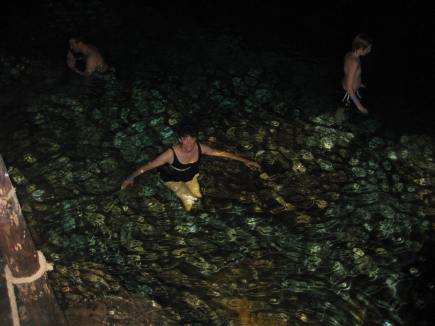My book has been sent to press!
While I wait for it to be printed I wanted to give those who were interested some background info on cenotes.
Even though my book is based on a fictional culture in a fictional village, I still had to do a lot of research. Even the most fantastic fiction has to have a foundation in truth. I had already read a lot about the Maya culture and about the Yucatan, but after I had completed several drafts I realized I would not be able improve my novel anymore unless I had a chance to go to Mexico and learn some things for myself. So I packed my bags, left my husband and four small children (this was pre-Levi) and went.
For fun, and to keep me safe from bandits I brought along this person:
We stayed with my aunt who has a winter home in Merida, Mexico.

This is my aunt. (That is not her winter home.)
My main objective on this trip was learn more about the Maya culture and and to visit the cenotes.
Yes, the word “cenote” is hard to pronounce or describe. Spellcheck doesn’t even recognize it. But when you consider that the original Maya word for cenote is dzonote, I think the word isn’t that hard after all, don’t you?
Dzonote means “well” as in “water well.” Basically, a cenote is a sinkhole that exposes the ground water, and the Yucatan is filled with them. Some are “mature” cenotes like the one in my book, others are “young” cenotes or “old” cenotes depending on whether or not they have collapsed yet and if there is any water left in them. Here is a diagram to give you an idea of what I mean:
Cenotes were significant to the ancient Maya people because it was the only place to get fresh water during the dry season. You might say cenotes were kinda important. Vital, actually. Because of this, cenotes also played a huge role in rituals and sacrifices, and many ceremonial artifacts–including human bones–have been discovered in cenotes. All of this plays into my book.
Zaci Cenote
This is the entrance to Zaci cenote.

You take these spooky steps into what you think will be cave.

But then it opens up into a huge pool, surrounded by a stone walkway. We would have gone swimming there but we were there on a Sunday, so alas, we did not. But it was beautiful. Nice that they have a rope across the pool in case you start to drown. 🙂
Loltun Cave
Since cenotes expose the groundwater, many cenotes are connected to each other underground. Sometimes they even have passages to the ocean, if they are near the coast. The Loltun Cave is a cave that connects several cenotes. These are “old” cenotes, so they are no longer filled with water (although they do get a lot of water in them during the rainy season, our guide told us. But then, he also told us that the reason why Mexican men have very little facial hair is because when they are infants their mamas take boiling-hot cloths and lay them on the places they want hair never to grow, so I cannot verify if the man is trustworthy.) If you ever go to Merida, you don’t want to miss this place. This cave was GIGANTIC and breathtaking. I would show you the photos of the inside but they are all too dark. This is the exit:
Those long rope-looking things are roots of banyan trees. Banyan trees love water and they often grow near cenotes with their roots “dripping” down to the surface of the water.
Sacred Cenote
This is one of the most famous cenotes, probably because it is in Chichen Itza, one of the biggest tourist stops in the Yucatan. On the day we were there they had it roped off so I couldn’t get a good angle with my camera. Too many tourists had been falling in, I suppose. Imagine trying to get someone out a cenote. Wow, that would be tricky. Someone should write a book about that.
Dzul-Ha Cenote at the Sotuta de Peon Hacienda
Finally, toward the end of our trip we got to actually swim in a cenote. The Dzul-Ha cenote is totally hidden underground. It was part of the Sotuta Hacienda and they had convenient outdoor stalls where you could change into your bathing suit (under the bright blue sky!) and then you go down the stairs into this cave where the cenote awaits, refreshing and cool. I am sure my sister is thrilled that the only photo I have of this cenote is of her. I was too busy swimming to care about posing in my bathing suit for ya’ll.

If you want to see some truly wondrous photographs of cenotes you should check these out:
http://www.melandramzi.com/activities-in-riviera-maya/cenotes/
http://galleonadventures.com/cenote-mexico-explore-riviera-maya-cenote-trail/
I hope that gives you a little more insight into what my book is about. Stay tuned!







Wow! Looks like a fun as well as educational trip!
LikeLike